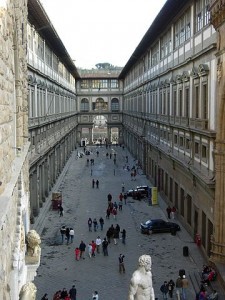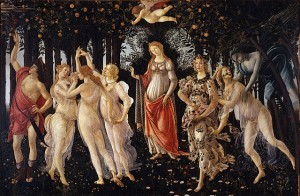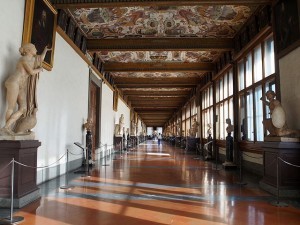The Uffizi Gallery is one of the most important museums in the world: the beauty and historic importance of its art collection puts it on the same level of institutions  like the MoMa in New York, the Louvre, the Hermitage, or the Aegyptian Museum in Cairo.
like the MoMa in New York, the Louvre, the Hermitage, or the Aegyptian Museum in Cairo.
The complete collection of the Uffizi inlcudes works from the Ancient Greece to the Venetian art of the 18th century, but the most interesting part of the museum is surely the one dedicated to the Renaissance, of course.
The building itself, Palazzo Uffizi, was built by the will of Cosimo I de Medici: the original project was designed by Vasari, and then completed, after the death of the Florentine architect, by Parigi and Buontalenti. This horseshoe-shaped palace was meant to become the heart of the Medici’s government and host offices, the courthouse, and artisans’ guilds. The construction of the building started in 1560, the works were then completed 20 years later.
Roaming across the halls of the Uffizi can be exhausting: you should plan a 3-4 hours visit, have a coffee at the bar on the terrace of the last floor when you’re tired. You can come back for a second visit or select which rooms to visit and which ones you should skip.
Second Floor: Corridoio di Levante
13th and 14th century art.
The second floor of Palazzo Uffizi is divided into two corridors divided by a loggia.
Roaming through the first halls of the Corridoio di Levante you’ll see some of most famous works of artists such as Giotto and Cimabue, along with a variety of other medieval paintings by skilled and innovative artists. Room 2 hosts paintings that once decorated the interior of several Tuscan churches: the room is indeed designed as a chapel and shows on its walls the works of Duccio di Buoninsegna, Giotto and Cimabue, that signed the transition from the Gothic style to a new one, planting the seed for the art of the Renaissance.
Room 3 is dedicated to Sienese artists of the 14th century, with works of Simone Martini – a wonderful Annunciation on a golden background – and a triptych by Pietro Lorenzetti. In the Room 4 pay attention to the Pietà di San Remigio, by Giotto’s pupil Giottino.
Gothic paintings are on show in Room 5 and 6. The highlight is surely the Adorazione dei Magi by Gentile da Fabriano.
Entering Room 7 you’ll immediately notice the masterpiece of Paolo Uccello, La Battaglia di San Romano. This is one of the most innovative medieval paintings you’ll ever see: it shows an accurate study of perspective, that will be the crucial characteristic of the arising modern art of the Renaissance.
In the following room you’ll admire the famous portraits of the Duke and Duchess of Urbino, with their hooked noses and red clothes, painted by Piero della Francesca. In the same room are the works of Filippo Lippi, Botticelli’s mentor. And finally, in the Room 9, you’ll have the chance to admire the first work of Sandro Botticelli, the Fortezza, a painting part of a series on virtues and capital sins created by the painter Piero del Pollaiolo.
Botticelli Hall.
This wide room is one of the most fascinating in the whole museum. It’s dedicated to one of the masters of the Renaissance: Sandro Botticelli. Among the 15 artworks on exhibition in the room you’ll immediately find the most famous (thanks to the crowd that stand right in front of them!): La Nascita di Venere (Birth of Venus), La Primavera (the Spring), and L’annunciazione (The Annunciation), l’Adorazione dei Magi (The Adoration of the Magi), and the Madonna del Magnificat (Madonna of the Magnificat). All these paintings have been painted by Botticelli between 1475 and 1490.
on exhibition in the room you’ll immediately find the most famous (thanks to the crowd that stand right in front of them!): La Nascita di Venere (Birth of Venus), La Primavera (the Spring), and L’annunciazione (The Annunciation), l’Adorazione dei Magi (The Adoration of the Magi), and the Madonna del Magnificat (Madonna of the Magnificat). All these paintings have been painted by Botticelli between 1475 and 1490.
After the Botticelli Hall you’ll enter the Leonardo Room (room 15), where there 2 works from the Florentine years of Leonardo da Vinci, his unfinished version of The Adoration of the Magi and L’Annunciazione, one of his most famous paintings.
The following room is called La Tribuna: it’s a small octagonal space that was created to host the portrays of Cosimo I’s family.
Nordic Reinassance.
In the Rooms 20 and 22 you’ll find the works of Flemish artists, such as Durer, with his Adoration of the Magi, and Hans Hemling (Virgin Mary with Baby Jesus and two angels).
Second Floor: Corridoio di Ponente
From the Renaissance to Mannerism.
At the end of the first corridor you’ll enter the loggia that will lead you to the second corridor, the Corridoio di Ponente, the opposite branch of the horseshoe outlined  by the palace. Walking across the loggia you’ll get a wonderful view of Florence, and then you’ll get to Room 25, the first of the corridor, where you’ll find on show one of Michelangelo’s most famous works: the Tondo Doni. The unusual structure of the painting and the vividness of its coulours (the same they had back in the 1506 when the artist finished it) are the reason of its well-deserved fame.
by the palace. Walking across the loggia you’ll get a wonderful view of Florence, and then you’ll get to Room 25, the first of the corridor, where you’ll find on show one of Michelangelo’s most famous works: the Tondo Doni. The unusual structure of the painting and the vividness of its coulours (the same they had back in the 1506 when the artist finished it) are the reason of its well-deserved fame.
Room 26 hosts Raffaello’s Madonna col cardellino, that surely gathers the attention of most of the visitors, but don’t miss portray of Leone X by Andrea del Sarto, a true masterpiece. Room 28 is dedicated to Venetian artists: among the paintings on exhibition here, Tiziano’s works definitely stand out. Don’t miss the Venere di Urbino, Flora and the astonishing portray of Eleonora Gonzaga della Rovere.
The halls that follow host works by Italian and foreign artists, from Tintoretto to Paolo Veronese, Rubens and Rembrandt.
First Floor
Baroque and Neoclassicism.
The itinerary continues on the first floor, moving to late 16th and 17th century art. The first room you’ll enter is the Caravaggio Hall. Here you have the chance to admire three masterpieces by the artist, the most important exponent of Italian Baroque style in painting: Bacco, Medusa, and Sacrificio di Isacco (Isacco’s Sacrifice), painted between 1595 and 1602. Caravaggio’s style is known for its extreme realism and for the wise use of light, an unprecedented feature in painting. To him we owe the invention of the chiaroscuro technique.
In the same room you’ll find Giuditta che decapita Oloferne, a painting from Artemisia Gentileschi, one of the first women that became famous as an artist in Italy, during the first half of the 17th century. Her debt to Caravaggio’s style is clear looking at the lights and the use of the chiaroscuro.






